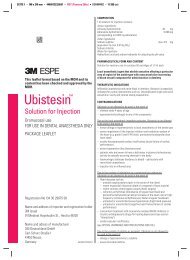EU HRT Core SPC update
EU HRT Core SPC update
EU HRT Core SPC update
Create successful ePaper yourself
Turn your PDF publications into a flip-book with our unique Google optimized e-Paper software.
System Organ Class<br />
General disorders and<br />
administration site<br />
conditions<br />
Common<br />
( 1/100 to < 1/10)<br />
Asthenia, localized<br />
oedema<br />
Uncommon<br />
( 1/1000 to < 1/100)<br />
vaginal candidiasis,<br />
vaginitis, vaginal<br />
dryness<br />
Generalized oedema,<br />
chest pain, malaise,<br />
sweating increased<br />
Rare<br />
(< 1/1000)<br />
Chills<br />
The most appropriate MedDRA term is used to describe a certain reaction and its synonyms<br />
and related conditions.<br />
Additional information on special populations<br />
The following, undesirable effects classified as at least possibly related to Angeliq treatment by<br />
the investigator, were recorded in 2 clinical studies in hypertensive women.<br />
Metabolism and nutrition disorders<br />
Hyperkalemia<br />
Cardiac disorders<br />
Cardiac failure, atrial flutter, QT interval prolonged, cardiomegaly<br />
Investigations<br />
Blood aldosterone increased.<br />
The following undesirable effects have been reported in association with <strong>HRT</strong> products:<br />
Erythema nodosum, eythema multiforme, chloasma and hemorrhagic dermatitis.<br />
Breast cancer risk<br />
An up to 2-fold increased risk of having breast cancer diagnosed is reported in women taking<br />
combined estrogen-progestagen therapy for more than 5 years. Any increased risk in users of<br />
estrogen-only therapy is substantially lower than that seen in users of estrogen-progestagen<br />
combinations. The level of risk is dependent on the duration of use (see section 4.4). Results of<br />
the largest randomised placebo-controlled trial (WHI study) and largest epidemiological study<br />
(MWS) are presented.<br />
Million Women Study – estimated additional risk of breast cancer after 5 years of use<br />
Age<br />
range<br />
(years)<br />
Additional cases per 1000<br />
never-users of <strong>HRT</strong> over a 5year<br />
period a<br />
Risk ratio b Additional cases per 1000<br />
<strong>HRT</strong> users over 5 years<br />
(95% CI)<br />
Estrogen-only <strong>HRT</strong><br />
50 - 65 9 - 12 1.2 1 - 2 (0 - 3)<br />
Combined estrogen-progestagen<br />
50 - 65 9 - 12 1.7 6 (5 - 7)<br />
a Taken from baseline incidences in developed countries.<br />
b Overall risk ratio. The risk ratio is not constant but will increase with increasing duration on use.<br />
Note: Since the background incidence of breast cancer differs by <strong>EU</strong> country, the number of<br />
additional cases of breast cancer differs by <strong>EU</strong> country, the number of additional cases of breast<br />
cancer will also change proportionately.<br />
US WHI studies - additional risk of breast cancer after 5 years of use<br />
Age range<br />
(years)<br />
Incidence per 1000 women<br />
in placebo arm over 5 years<br />
Risk ratio & 95% CI Additional cases per 1000<br />
<strong>HRT</strong> users over 5 years
















